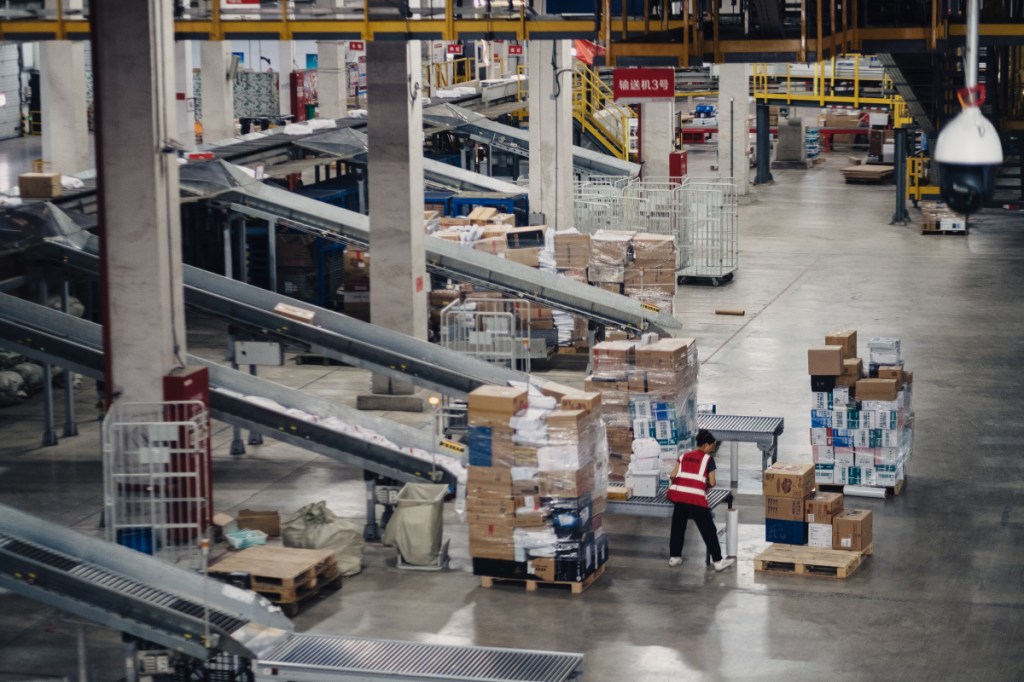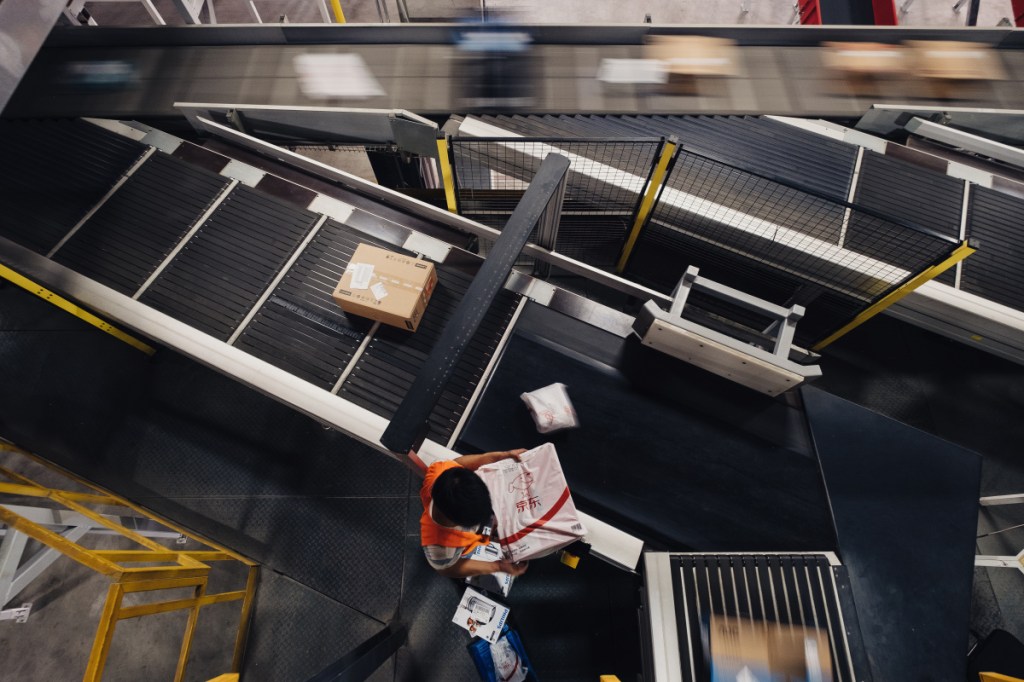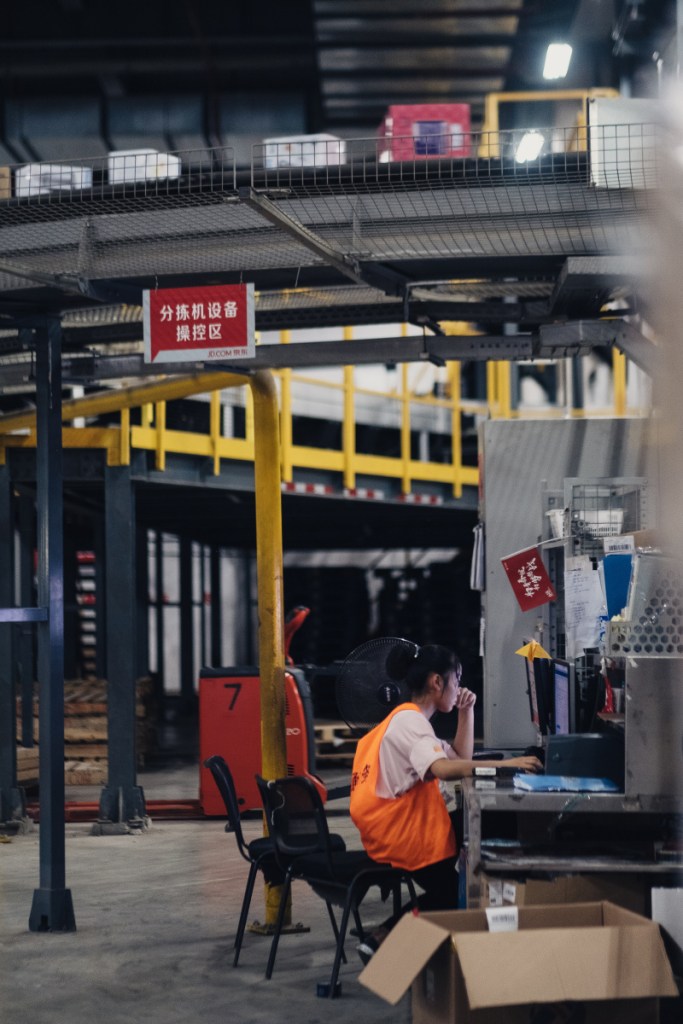SHANGHAI — Inside a warehouse the size of seven football fields, hundreds of robots pack roughly 200,000 boxes each day and ship them to customers across China. Four humans babysit.
One is Zou Rui, 25, a soft-spoken engineer who stands for much of his eight-hour shift in New Balance sneakers, monitoring a milky white mechanical arm. It plunges up and down like a pecking chicken, grabbing parcels with a suction-cupped hand and dropping them into containers on a conveyor belt.
If something looks odd, Zou rushes to fix it. Otherwise, he said, he jots notes in a binder, tracking the arm’s performance for his remote bosses. Or he chats online with his colleagues: two men and a woman, all about his age.
Here, Zou is far from his family’s cornfields in the eastern province of Anhui, far from the bustle of his old workspace with 100 or so people. But he doesn’t feel isolated.
“I don’t get lonely,” he said, “because of the robots.”
Zou works for the Chinese e-commerce giant JD.com, which lauds this warehouse on the outskirts of Shanghai as one of the most automated in the world. Analysts say it’s a peek at the future of manual work in China and beyond – a place where a chosen few tend to the machines, while most workers have been rendered obsolete.
Thanks to a “strategic partnership” with Google, that future could be coming soon to the United States.
But chief executive Richard Liu wants to take the high-tech concept even further in a country once known as a hub for cheap labor.
“I hope my company would be 100 percent automation someday,” Liu said at an April retail conference in Madrid. “No human beings anymore.”
His facility near Shanghai serves as a learning lab for the company – which reported a slim $18 million in profit last year on revenue of $55.7 billion. Executives hope it will prove to be a not-so-secret weapon against competitors Alibaba and Amazon, which are also racing to develop the next generation of e-commerce super machines.
While in the United States on a business trip, Liu was arrested on Aug. 31 in Minneapolis on suspicion of rape. He was released, and no charges were filed. Liu returned to China, and JD.com issued a statement Sept. 5 claiming that Minneapolis police found no misconduct by Liu. The police investigation, however, remains open.
JD aims to perfect its technology, spread it to the firm’s 500-plus other warehouses across China, Thailand and Indonesia, which still depend on thousands of people, and eventually sell the system to businesses that want to shrink their own labor costs.
As of today, JD employs roughly 160,000 full-time workers in Asia. Over the next decade, Liu said, he hopes to see that number dwindle to “less than 8,000” better-paid staffers who work two or three hours daily.
The jobs would be “easier, more fun and less dangerous,” the company head said this spring.
JD signed its deal with Google in June, and Google announced plans to invest $550 million in the firm.
“This marks an important step in the process of modernizing global retail,” JD’s chief strategy officer, Jianwen Liao, said at the time.
JD also opened its first Chinese grocery store this year with Walmart. Shoppers there can pay with their smartphones.
The partnership with Google is expected to boost Google Shopping, a search engine for goods, and intensify the U.S. company’s domestic rivalry with Amazon, which has deployed more than 100,000 robots of its own around the globe.
Amazon, which launched its robotics program in 2014, doesn’t have any fully automated warehouses, but its fulfillment centers manage a wider variety of packages than JD’s four-person shop does. (Amazon’s chief executive, Jeff Bezos, owns The Washington Post.)
In the warehouse where Zou works, machines guided by image scanners handle all the goods, largely cellphones and cameras and other rectangular-shaped electronics.
Packages travel along a highway of belts. Mechanical arms stationed throughout the network place the items on the right tracks, wrap them in plastic or cardboard and set them onto motorized pucks dubbed “little red men” – a nickname inspired by the spunky creatures in the Minions films.
The little red men carry the parcels across a floor that resembles a giant checkerboard and plunk them down chutes to sacks. Computerized shelves on wheels retrieve the loads and transport them to trucks, which deliver most orders within 24 hours of a shopper’s click.
While people still outperform robots on a range of tasks – lifting objects of various shapes and sizes, for example – economists predict that JD and other e-commerce businesses are leading a shift that will displace millions of workers worldwide in retail and manufacturing.
“This is the kind of technology I expect will disperse everywhere,” said Martin Ford, author of “Rise of the Robots,” which explores how artificial intelligence could reshape the labor market. “It’s absolutely inevitable that this will be a lot more disruptive than people imagine.”
A swath of jobs that follow patterns will vanish, Ford said – the global consultancy McKinsey predicts that robots could replace almost a third of the American workforce by 2030 – and a new crop of highly skilled positions will emerge.
Demand is expected to swell for workers who can program and monitor machines, as well as for managers with superior communication styles. (Artificial intelligence struggles with empathy.)
Peter Yu, chief technology officer of XYZ Robotics, a start-up that focuses on supply-chain automation, said workers shouldn’t fear the change.
Automation, he said, will swap boring jobs for better-paying and more stimulating work. The United States’ estimated 908,000 warehouse employees (who don’t all work in e-commerce) hardly socialize, anyway, Yu said.
“They have to run around here and there and pick up objects,” Yu said. “They don’t have much time to talk to other people.”
At JD, Cheng Hui, head of robotics research for the firm in San Francisco, said market forces propel the scramble to automate.
China is grappling with a labor shortage, he said.
The country’s one-child policy, which was in place from 1979 to 2016, shaved down today’s number of young job seekers, giving workers more leverage to ask for higher pay and better benefits.
Government officials have admitted the policy stifled population growth, making it tougher and more expensive for companies to fill vacancies.
Yao Meixiong, deputy director of the census with the Fujian Provincial Bureau of Statistics, has estimated that China’s young workforce (20 to 34) in 2030 would total 221 million, down 104 million from 2010.
“The logistics talent pool is not increasing as fast as what we need,” JD’s Cheng said. “In that sense, automation will help to relieve that demand.”
For Zou, landing a job at JD’s first fully automated warehouse felt like a promotion.
He started work in August 2017, leaving another fulfillment center – only 90 percent automated – and the duty of making sure orders were shipped on time. (His contract, he said, prevents him from talking about his salary.)
“The robots reduce the jobs that are boring,” Zou said.
He doesn’t share the fear that machines will take over. After all, he said, his role didn’t exist a little more than a year ago.
Zou remembers making his first online purchase as a teenager: a custom-made basketball jersey.
“This is the future,” he thought, and it seemed more interesting than selling corn with his parents.
He went to business school near his hometown, but higher education didn’t prepare him for the specifics of the JD job. Zou completes a training course every two months – the technology evolves that quickly.
Aside from work, he said, he hopes to get married, have kids someday and keep building his career in e-commerce, “an industry with great prospects.”
“I want to help popularize this technology,” Zou said. “I want to help spread it around.”
Send questions/comments to the editors.





Success. Please wait for the page to reload. If the page does not reload within 5 seconds, please refresh the page.
Enter your email and password to access comments.
Hi, to comment on stories you must . This profile is in addition to your subscription and website login.
Already have a commenting profile? .
Invalid username/password.
Please check your email to confirm and complete your registration.
Only subscribers are eligible to post comments. Please subscribe or login first for digital access. Here’s why.
Use the form below to reset your password. When you've submitted your account email, we will send an email with a reset code.